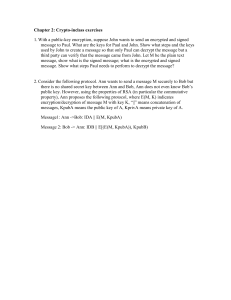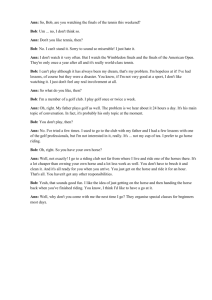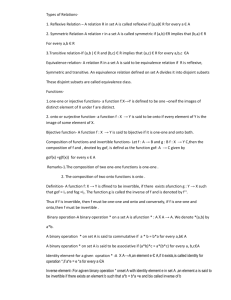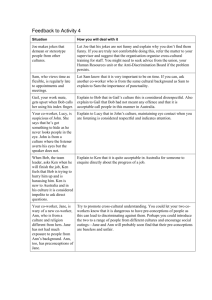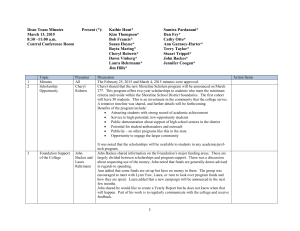relation
advertisement
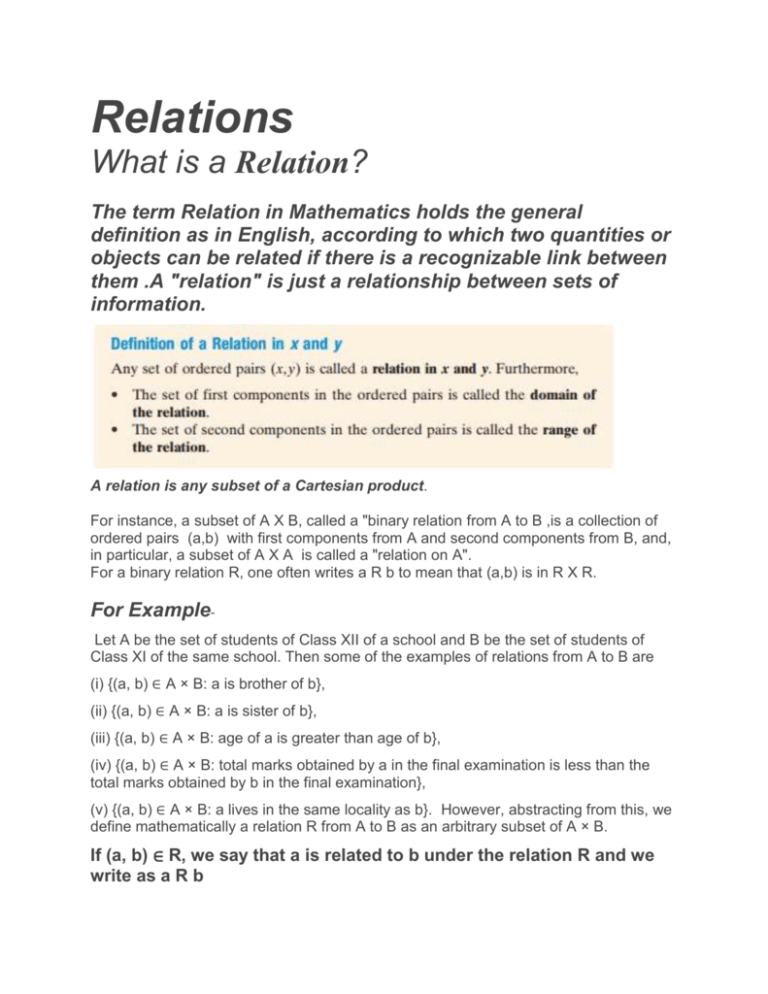
Relations
What is a Relation?
The term Relation in Mathematics holds the general
definition as in English, according to which two quantities or
objects can be related if there is a recognizable link between
them .A "relation" is just a relationship between sets of
information.
A relation is any subset of a Cartesian product.
For instance, a subset of A X B, called a "binary relation from A to B ,is a collection of
ordered pairs (a,b) with first components from A and second components from B, and,
in particular, a subset of A X A is called a "relation on A".
For a binary relation R, one often writes a R b to mean that (a,b) is in R X R.
For ExampleLet A be the set of students of Class XII of a school and B be the set of students of
Class XI of the same school. Then some of the examples of relations from A to B are
(i) {(a, b) ∈ A × B: a is brother of b},
(ii) {(a, b) ∈ A × B: a is sister of b},
(iii) {(a, b) ∈ A × B: age of a is greater than age of b},
(iv) {(a, b) ∈ A × B: total marks obtained by a in the final examination is less than the
total marks obtained by b in the final examination},
(v) {(a, b) ∈ A × B: a lives in the same locality as b}. However, abstracting from this, we
define mathematically a relation R from A to B as an arbitrary subset of A × B.
If (a, b) ∈ R, we say that a is related to b under the relation R and we
write as a R b
Types of Relations
Empty Relations
Universal Relations
Identity Relation
Empty Relation
A relation R in a set A is called empty relation, if no element of A is related
to any element of A, i.e., R = φ ⊂ A × A.
Universal Relation:
A relation R in a set A is called universal relation, if each element of A is
related to every element of A, i.e., R = A × A.
Identity Relation
The identity relation is true for all pairs whose first and second element are
identical ,i.e., R= { (x,x)| x∈ A} ⊂ A x A
EXAMPLE
All these relations are definitions of the relation "likes" on the set {Ann, Bob, Chip}.
Happy world
In this world, "likes" is the full relation on the universe. Because it is full, every person
likes every other person, including him- or herself. The extension of this "likes" relation
is {(Ann,Ann),(Ann,Bob),(Ann,Chip),(Bob,Ann),(Bob,Bob),(Bob,Chip),
(Chip,Ann),(Chip,Bob),(Chip,Chip)}.
Narcissistic world
In this world, "likes" is the identity relation on the universe. Because it is the identity
relation, every person likes him- or herself, but no one else. The extension of this
"likes" relation is {(Ann,Ann),(Bob,Bob),(Chip,Chip)}.
Emptily unhappy world
In this world, "likes" is the empty relation. Because it is empty, no person likes any
other person, including him- or herself. The extension of this "likes" relation is { }.
A relation R in a set A is said to be an equivalence relation if R is
reflexive, symmetric and transitive
Examples using Ann, Bob, and Chip:
Happy world
"likes" is reflexive, symmetric, and transitive. (It is an equivalence relation.)
Narcissistic world
"likes" is reflexive, symmetric, antisymmetric, and transitive. (It is both an
equivalence relation and a non-strict order relation, and on this world
produces an antichain.)
Emptily unhappy world
"likes" is not reflexive, and is trivially irreflexive, symmetric, antisymmetric,
and transitive.
Circularly unhappy world
This world's extension of "likes" is {(Ann,Bob),(Bob,Chip),(Chip,Ann)}.
"likes" is irreflexive, antisymmetric, and not transitive.
Somewhat-happy world with 2-circuit
This world's extension of "likes" is {(Ann,Bob),(Bob,Ann),(Chip,Chip)}.
"likes" is neither reflexive nor irreflexive, but is both symmetric and
transitive..
Happy world with 2-circuit
This world's extension of "likes" is
{(Ann,Ann),(Ann,Bob),(Bob,Ann),(Bob,Bob),(Chip,Chip)}. "likes" is
reflexive, symmetric, and transitive.. (It is an equivalence relation.)
Functions
How to identify a Function?
A Function is a special set of Relation , which has
only one range value for each domain.
Types of Function:
Injective
Surjective
A function f : X → Y is defined to be one-one (or injective), if the
images of distinct elements of X under f are distinct, i.e., for
every x1, x2 ∈ X, f(x1) = f(x2) implies x1 = x2. Otherwise, f is
called many-one.
The function f1 and f4 in Fig 1.2 (i) and (iv) are one-one and the
function f2 and f3 in Fig 1.2 (ii) and (iii) are many-one.
A function f : X → Y is said to be onto (or surjective), if every
element of Y is the image of some element of X under f, i.e., for
every y ∈ Y, there exists an element x in X such that f(x) = y.
The function f3 and f4 in Fig 1.2 (iii), (iv) are onto and the
function f1 in Fig 1.2 (i) is not onto as elements e, f in X2 are not
the image of any element in X1 under f1.
Composition of Functions and Invertible Function
Composition of Functions
Let f : A → B and g : B → C be two functions. Then the composition of f and g,
denoted by gof, is defined as the function gof : A → C given by gof(x) = g(f(x)), ∀ x
∈ A.
Invertible Function
A function f : X → Y is defined to be invertible, if there exists a function g : Y →
X such that gof = IX and fog = IY. The function g is called the inverse of f and is
denoted by f -1.
Thus, if f is invertible, then f must be one-one and onto and
conversely, if f is one-one and onto, then f must be invertible.
This fact significantly helps for proving a function f to be invertible
by showing that f is one-one and onto, specially when the actual
inverse of f is not to be determined.
Binary Operations
A binary operation ∗ on a set A is a function ∗ : A × A → A. We
denote ∗ (a, b) by a ∗ b
1. A binary operation ∗ on the set X is called commutative, if a ∗ b = b ∗ a, for every
a, b ∈ X.
Since a + b = b + a and a × b = b × a, ∀a, b ∈ R, ‘+’ and ‘×’ are commutative
binary operation.
However, ‘–’ is not commutative, since 3 – 4 ≠ 4 – 3. Similarly, 3 ÷ 4 ≠ 4 ÷ 3
shows that ‘÷’ is not commutative
2. A binary operation ∗ : A × A → A is said to be associative if (a ∗ b) ∗ c = a ∗ (b ∗
c), ∀a, b, c, ∈ A.
Addition and multiplication are associative, since (a + b) + c = a + (b + c) and
(a×b) × c = a × (b × c) ∀ a, b, c ∈ R.
However, subtraction and division are not associative, as (8 – 5) – 3 ≠ 8 – (5 – 3)
and (8 ÷ 5) ÷ 3 ≠ 8 ÷ (5 ÷ 3)
3. Given a binary operation ∗ : A × A → A, an element e ∈ A, if it exists, is called
identity for the operation ∗, if a ∗ e = a = e ∗ a, ∀ a ∈ A.
a + 0 = 0 + a = a and a × 1 = a = 1 × a, ∀a ∈ R implies that 0 and 1 are identity
elements for the operations ‘+’ and ‘×’ respectively.
Further, there is no element e in R with a – e = e – a, ∀a. Similarly, we can not
find any element e in R, such that a ÷ e = e ÷ a, ∀a in R∗. Hence, ‘–’ and ‘÷’ do
not have identity element.
4. Given a binary operation ∗ : A × A → A with the identity element e in A, an
element a ∈ A is said to be invertible with respect to the operation ∗, if there
exists an element b in A such that a ∗ b = e = b ∗ a and b is called the inverse of
a and is denoted by a-1.
As a + (– a) = a – a = 0 and (– a) + a = 0, – a is the inverse of a for addition.
Similarly, for a ≠ 0, a ×1/ a = 1 = 1/ a × a implies that 1/ a is the inverse of a
for multiplication.
Since – a ∉ N, – a can not be inverse of a for addition operation on N,
although – a satisfies a + (– a) = 0 = (– a) + a.
Similarly, for a ≠ 1 in N, 1/ a ∉ N, which implies that other than 1 no element of
N has inverse for multiplication operation on N.
